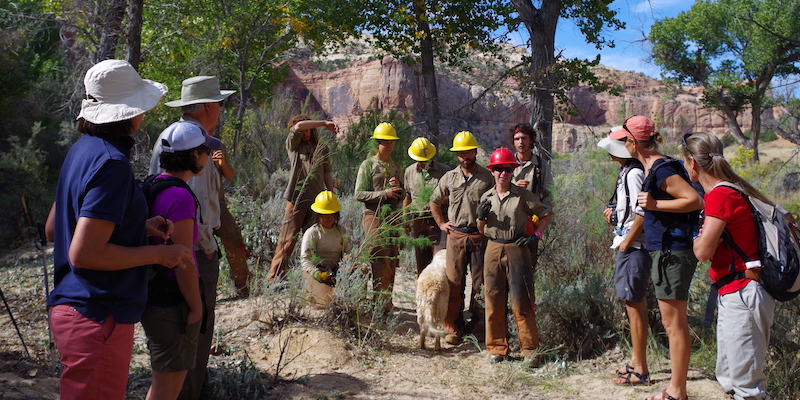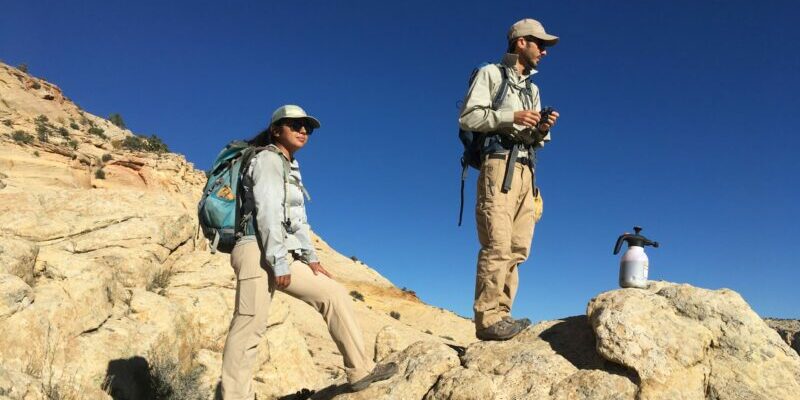Conservation
Partners works with the Escalante River Watershed Partnership to promote ecosystem and watershed health through the control of invasive species, and the conservation of native species and their habitats, throughout the Escalante watershed and beyond.
Featured
Partnerships
Continued partnerships with local, state, and regional government agencies and conservation organizations to complete a science and monitoring plan inclusive of Indigenous knowledge and aimed at protecting Monument resources and realizing its scientific value.
Learn more about the programs we do in the Monument


The Escalante River Watershed Partnership (ERWP)
Conservation
The Escalante River is a ribbon of green winding through a vast desert landscape, an important resource for wildlife and habitat of Grand Staircase. It is also a vital water source for residents of the nearby towns of Boulder and Escalante, who rely on it for agriculture and drinking water. Like much of the southwest, though, the river is under increasing pressure of climate change, invasive species, and withdrawal,
The Escalante River Watershed Partnership (ERWP), formed in 2009, is a collaboration of state and federal agencies, nonprofit organizations, local businesses, recreation guides, and private landowners that works to coordinate science and riparian restoration projects in the Escalante River basin. The initial target was the removal of woody invasive species along the Escalante River and its tributaries, but has since grown to include studies of unique habitats, springs and seeps, rare and threatened species, and river channel morphology, among much else. GSEP remains a leading force in carrying out the goals and work of ERWP in science and conservation.
GSEP has taken the lead on the largest ERWP effort to date—the comprehensive treatment of woody invasive species in the Escalante River watershed:
Woody invasive species Russian olive (Elaeagnus angustifolia) and tamarisk (Tamarix spp.) create havoc in riparian ecosystems of the Southwest. Growing in dense stands along the river corridor, they narrow the stream channel, altering natural hydrologic processes such as sediment deposition and channel meandering and raising water temperature. The result is a simplified aquatic habitat that negatively impacts populations of fish and invertebrates, which have less cover from predators and degraded water quality. Woody invasives also grow extremely quickly, outcompeting native woody plant species such as willows and cottonwoods along riverbanks. Highly impacted areas consist of monotypic stands that crowd out even native understory forbs and grasses. This loss of biodiversity affects the entire community of plants and animals that rely on the river. For example, Russian olive and tamarisk provide a poorer food source and cover for birds and mammals, forcing them to travel further in search of appropriate resources.
For over ten years, GSEP has been leading field crews in removing Russian olive and tamarisk throughout the Escalante River watershed. Working with crews from the Utah Conservation Corps, among others, GSEP cuts Russian olive and tamarisk and sprays stumps with herbicide, restoring natural conditions and allowing for recovery and of native plants and wildlife.
ERWP recently celebrated the completion of 90 miles of treatment of Russian olive along the Escalante River, and treatment of tributaries is nearly complete. GSEP staff works with Conservation Legacy to monitor permanent plots throughout the watershed where treatment has occurred. Results have shown remarkable recovery in native plant species and overall improvement of habitat.
Ways of Understanding and Protecting Land and Water Resources in the Grand Staircase-Escalante Region
On March 3-4, 2022, ERWP and Southern Utah University co-hosted a Grand Staircase-Escalante Symposium: Ways of Understanding and Protecting Land and Water Resources in the Grand Staircase-Escalante Region.

